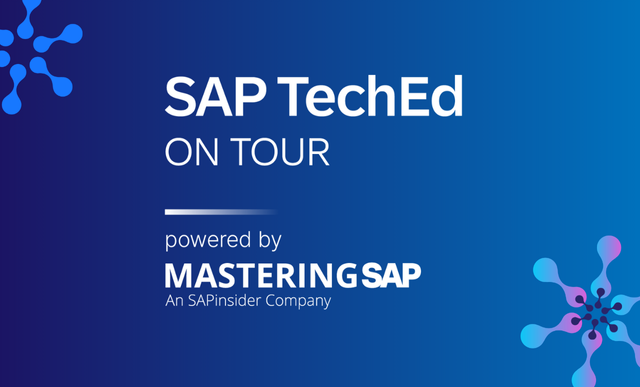SAP Accounting
Filter By
Browse By
- SAP Analytics and AI
- SAP Application Development and Integration
- All SAP Application Development and Integration
- SAP ABAP
- SAP ABAP Development Tools
- SAP ABAP Test Cockpit
- SAP API Management
- SAP BAPI
- SAP Basis
- SAP BRF
- SAP Business Application Studio
- SAP CMS
- SAP Design Studio
- SAP Development Tools
- SAP DevOps
- SAP EAI
- SAP EDI
- SAP Extension Suite
- SAP Fiori
- SAP Fiori Elements
- SAP Integration Suite
- SAP Low Code Application Development
- SAP Low Code Automation
- SAP Netweaver
- SAP Release Management
- SAP UI5
- SAP Web Application Server
- SAP Web IDE
- SAP Business Process Management
- SAP Center of Excellence
- SAP CIO
- SAP Customer Experience
- SAP Data and Data Management
- All SAP Data and Data Management
- SAP BW
- SAP BW/4HANA
- SAP Crystal Reporting
- SAP Data Archiving
- SAP Data Center
- SAP Data Governance
- SAP Data Integration
- SAP Data Migration
- SAP Data Quality
- SAP Data Services
- SAP Data Strategy
- SAP Data Visualization
- SAP Data Warehouse Cloud
- SAP DMS
- SAP Document Control
- SAP EIM
- SAP ETL
- SAP ETL Tools
- SAP HANA
- SAP HANA Administration
- SAP HANA Deployment Infrastructure
- SAP HANA Studio
- SAP Master Data
- SAP Master Data Governance
- SAP MDM
- SAP Enterprise Architect
- SAP Enterprise Asset Management
- SAP ERP
- SAP Finance
- All SAP Finance
- SAP Accounting
- SAP AR AP
- SAP Asset Accounting
- SAP Billing Systems
- SAP BPC
- SAP BRIM
- SAP Cash Management
- SAP Central Finance
- SAP Controlling
- SAP COPA
- SAP Cost Center Accounting
- SAP e-invoicing
- SAP FICO
- SAP Finance Automation
- SAP Financial Closing Cockpit
- SAP Financial Consolidation
- SAP Financial Planning
- SAP FX Risk
- SAP General Ledger
- SAP Global Tax Management
- SAP Hyperion
- SAP Order to Cash
- SAP Payment Processing
- SAP Profitability Analysis
- SAP Rebate Management
- SAP S/4HANA Finance
- SAP Universal Journal
- SAP Governance Risk and Compliance
- SAP Human Capital Management
- SAP Intelligent Technologies
- SAP Platform and Technology
- All SAP Platform and Technology
- SAP Business Technology Platform
- SAP Cloud Connector
- SAP Cloud Integration Platform
- SAP Cloud Migration
- SAP Cloud Platform
- SAP Cloud Providers
- SAP Cloud Strategy
- SAP Container Platform
- SAP Digital Asset Management
- SAP Digital Integration Hub
- SAP Digital Signature
- SAP HANA Enterprise Cloud
- SAP HEC
- SAP Hyperscalers
- SAP Infrastructure
- SAP Messaging
- SAP Smart Forms
- SAP Quality and Testing
- SAP Security
- SAP Spend Management
- SAP Supply Chain Management
- All SAP Supply Chain Management
- SAP APO
- SAP Asset Management
- SAP Business Network
- SAP Digital Manufacturing Cloud
- SAP Digital Twin
- SAP EWM
- SAP IBP
- SAP Inventory Management
- SAP Label Printing
- SAP Logistics
- SAP Manufacturing
- SAP Manufacturing Automation
- SAP MES
- SAP MII
- SAP MM
- SAP MRO
- SAP MRP
- SAP Order Management
- SAP Plant Maintenance
- SAP PLM
- SAP Production Planning
- SAP S&OP
- SAP SD
- SAP SPM
- SAP Supply Chain Planning
- SAP Track and Trace
- SAP Transportation Management
- SAP System Administration
SAP Accounting: An overview and key considerations
What Is SAP Accounting?
SAP Accounting consists of two core modules that represent separate accounting books. SAP customers utilize SAP Financial Accounting (FI) for external reporting with financial statements and SAP Controlling (CO) for internal reporting purposes.
SAP Accounting enables organizations to deliver financial performance information necessary for effective decision-making by consolidating data from functional modules with powerful reporting tools. It is critical to ensure all aspects of an organization’s financials are integrated in a way that makes it easier for finance and accounting managers to access the information they need when they need it. SAP accounting modules are designed to make managing and reporting accounting data easier across organizations, teams, and roles, to support the generation of income statements, balance sheets, and cash flow statements.
For many organizations, SAP Accounting manages transactions across these core financial functions:
- Accounts payable/accounts receivable
- Bank accounting
- Cash journal
- Financial close
- Financial statements
- Fixed asset accounting
- General ledger
- Inventory
- Master data governance
- Multiple charts of accounts and parallel valuations
- Tax accounting.
Key Considerations for SAPinsiders
SAP Accounting: An overview and key considerations
What Is SAP Accounting?
SAP Accounting consists of two core modules that represent separate accounting books. SAP customers utilize SAP Financial Accounting (FI) for external reporting with financial statements and SAP Controlling (CO) for internal reporting purposes.
SAP Accounting enables organizations to deliver financial performance information necessary for effective decision-making by consolidating data from functional modules with powerful reporting tools. It is critical to ensure all aspects of an organization’s financials are integrated in a way that makes it easier for finance and accounting managers to access the information they need when they need it. SAP accounting modules are designed to make managing and reporting accounting data easier across organizations, teams, and roles, to support the generation of income statements, balance sheets, and cash flow statements.
For many organizations, SAP Accounting manages transactions across these core financial functions:
- Accounts payable/accounts receivable
- Bank accounting
- Cash journal
- Financial close
- Financial statements
- Fixed asset accounting
- General ledger
- Inventory
- Master data governance
- Multiple charts of accounts and parallel valuations
- Tax accounting.
Key Considerations for SAPinsiders
Prioritize industry-specific and business process-related compliance needs across accounting and finance requirements. SAP Accounting is an essential component of SAP ERP that provides organizations with global processes and information to account for the new standards of accounting, while maintaining flexibility to incorporate regulatory updates. SAP Accounting solutions can help organizations effectively meet global accounting and financial reporting standards to enforce compliance.
Consider opportunities to modernize accounting workstreams and provide operational visibility across virtual teams.The transition to a fully remote working environment has caused difficulties for accounting professionals, particularly as it relates to their dependence on spreadsheets, inability to access data, limited process documentation, and daily manually intensive tasks. Organizations can automate their workflows with SAP Accounting tools, freeing them to do more optimization and customization.
Leverage SAP Accounting products to enable accounting teams to do more with less. COVID-19 variants, virtual work, supply chain disruptions, inflation concerns, and the Great Resignation, represent some of the major challenges creating uncertainty for organizations across the current operating environment. With the uncertainty of this economy, accounting is required to give more up-to-date information to make smarter decisions in real time.
973 results
-

Troubleshoot the Three SAPSprint Root Error Categories for Server-Based Printing on Windows
Published: 29/October/2009
Reading time: 17 mins
A failed printout can delay or disrupt important meetings or cause you to miss deadlines. See how to avoid printer failures when using SAPSprint by analyzing the three most common types of errors. Also find answers to common SAPSprint issues in the SAPSprint FAQs. Key Concept Processing in SAPSprint involves generating print data via the...…
-

Use Down Payment Chain Functionality to Improve Efficiency of Tracking Contractual Events
Published: 13/July/2011
Reading time: 18 mins
Track contractual events that occur in long-term projects with the down payment chain functionality in FI. Walk through the end-to-end configuration of the functionality supported by process steps with an example. Key Concept SAP’s down payment chains functionality groups all the accounting documents that belong to one contract. It also allows you to structure the...…
-

How to Use SAP’s Multiple Calendar Tool for Asset Accounting to Manage Multiple Fiscal Calendars
Published: 19/June/2014
Reading time: 10 mins
Discover how the Multiple Calendar Tool from SAP solves the requirement to create financial statements or tax values in more than one fiscal calendar. Key Concept The Multiple Calendar Tool is an add-on component to Asset Accounting that provides the required functionality to facilitate the creation of accurate financial statements for different fiscal calendars. The...…
-
-

CNH Industrial Cultivates Automated Account Reconciliation Landscape
Published: 20/July/2017
Reading time: 10 mins
CNH Industrial, a global capital goods corporation specializing in the manufacture of agricultural and construction equipment, along with commercial vehicles and powertrain solutions, takes pride in designing and producing machines that “keep agriculture and industry growing.” But with more than 63,000 employees, 64 manufacturing plants, and 50 research and development centers, managing financial tasks is…
-

Uncover New Insight into Your Customers with mySAP CRM Analytics
Published: 15/August/2006
Reading time: 27 mins
Find out how mySAP CRM Analytics, a group of tools offered with mySAP CRM 2005 and SAP NetWeaver Business Intelligence to help you optimize your customer data. Learn about the mySAP CRM extraction mechanism and cross-application analysis tools you can use with your data. Then, explore the standard tool sets available, including customer analytics, product...…
-

Facilitate the Data Exchange Between Headquarters and Subsidiaries with SAP In-House Cash
Published: 05/December/2010
Reading time: 17 mins
Become familiar with the most important business configuration settings of SAP In-House Cash. Get a step-by-step introduction to how to prepare both the subsidiary systems and the in-house cash center for the key business processes of SAP In-House Cash. Understand the setup of the principal master data for SAP In-House Cash. Key Concept SAP In-House...…
-

Create Online Vendor Payments Using Payment Requests
Published: 12/March/2010
Reading time: 14 mins
In the standard payment transaction F110, outgoing payments are all based on financial documents. By using online payments, you can create payments without any underlying financial document. Instead of a financial document, the basis for the online payment is a payment request. You create the payment requests with transaction FIBLAPOP and the outgoing payment with...…
-
-

Technical Guide: Add Currencies using S/4HANA Finance 1809
Published: 25/October/2018
Reading time: 10 mins
Traditionally, once you have gone live in a production system, the SAP system gives you a warning message (Figure 1) when you try to add a currency in the ledgers definition, and you then need SAP System Landscape Optimization (SLO) service for such a change in your currency setup. Figure 1 – Issue when adding…
-

How to Setup Demand Planning in SAP Advanced Planning and Optimization
Published: 21/May/2020
Reading time: 21 mins
SAP Advanced Planning and Optimization, demand planning allows a business to perform forecasting of their materials while considering all the factors that affect the demand. Demand planning is periodic and contains multi-step processes such as data gathering, statistical analysis, reviewing market intelligence reports, and performing adjustments against budgeted forecast to drive material requirements planning. SAP…
-

SAP Cloud ALM – The essential tool for any SAP Cloud implementation
Reading time: 3 mins
After over 20 years of experience with SAP, I’ve found SAP Cloud ALM to be an efficient, user-friendly tool for managing the entirety of SAP projects, providing integrated project management capabilities, real-time visibility, and cost-effective solutions that enhance collaboration and streamline SAP S/4HANA implementations.
Featured Experts
-

Carles Lamas Martinez
PARTNER, CUVIV BUSINESS SERVICES SL
-

Clifford Seckman
President, Virginia Software Group, Inc.
Become a Member
Unlimited access to thousands of resources for SAP-specific expertise that can only be found here.
Upcoming Events
-

Mastering SAP Collaborate an SAP TechEd on Tour event
November 12 - 14, 2025
Sydney, New South Wales
Australia
View Event
Related Vendors
Your request has been successfully sent

